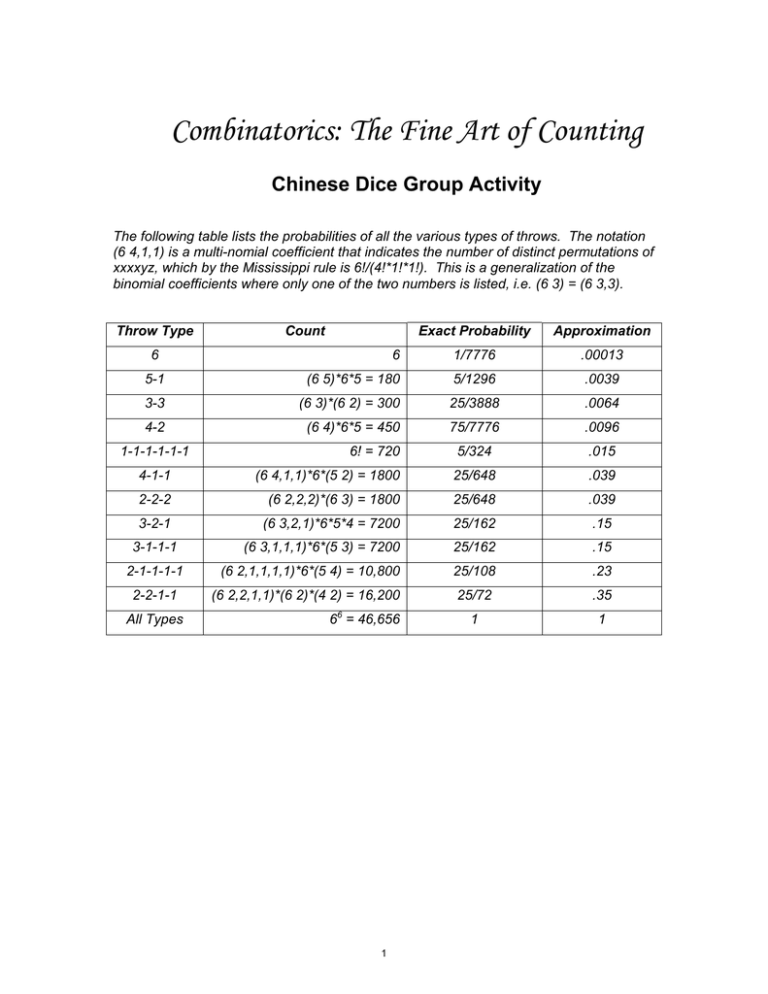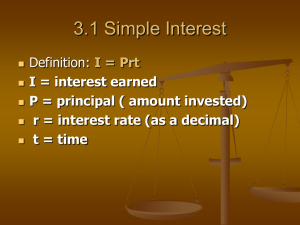Combinatorics: The Fine Art of Counting Chinese Dice Group Activity
advertisement

Combinatorics: The Fine Art of Counting Chinese Dice Group Activity The following table lists the probabilities of all the various types of throws. The notation (6 4,1,1) is a multi-nomial coefficient that indicates the number of distinct permutations of xxxxyz, which by the Mississippi rule is 6!/(4!*1!*1!). This is a generalization of the binomial coefficients where only one of the two numbers is listed, i.e. (6 3) = (6 3,3). Throw Type Count Exact Probability Approximation 6 1/7776 .00013 5-1 (6 5)*6*5 = 180 5/1296 .0039 3-3 (6 3)*(6 2) = 300 25/3888 .0064 4-2 (6 4)*6*5 = 450 75/7776 .0096 6! = 720 5/324 .015 4-1-1 (6 4,1,1)*6*(5 2) = 1800 25/648 .039 2-2-2 (6 2,2,2)*(6 3) = 1800 25/648 .039 3-2-1 (6 3,2,1)*6*5*4 = 7200 25/162 .15 (6 3,1,1,1)*6*(5 3) = 7200 25/162 .15 (6 2,1,1,1,1)*6*(5 4) = 10,800 25/108 .23 (6 2,2,1,1)*(6 2)*(4 2) = 16,200 25/72 .35 1 1 6 1-1-1-1-1-1 3-1-1-1 2-1-1-1-1 2-2-1-1 All Types 66 = 46,656 1 Combinatorics: The Fine Art of Counting “Craps” Group Activity Let W1 be the event of winning on the initial roll, let L1 be the event of losing on the first roll, and let Pk be the event of rolling the point value k on the first roll. P(W1) = 6/36+2/36 = 2/9 P(P4) = P(P10) = 3/36 = 1/12 P(P6) = P(P8) = 5/36 P(L1) = 1/36+2/36+1/36 = 1/9 P(P5) = P(P9) = 4/36 = 1/9 Let W be the event of winning. P(W) = P(W1) + 2*P(P4)*P(W|P4) + 2*P(P5)*P(W|P5) + 2*P(P6) *P(W|P6) Note that the probability rolling a given point value prior to rolling a 7 is the probability of not rolling either the point value or a 7 an arbitrary number of times (possibly zero) followed by rolling the point value. Probability of not rolling a 4 or a 7 = 1 – (1/12+1/6) = 3/4 P(W|P4) = 1/12 + (3/4)*(1/12) + (3/4)2*(1/12) + (3/4)3*(1/12) + … P(W|P4) = 1/12 * [1/(1 - 3/4)] = 1/3 Probability of not rolling a 5 or a 7 = 1 – (1/9+1/6) = 5/18 P(W|P5) = 1/9 + (13/18)*(1/9) + (13/18)2*(1/9) + (13/18)3*(1/9) + … P(W|P5) = 1/9 * [1/(1 - 13/18)] = 2/5 Probability of not rolling a 6 or a 7 = 1 – (5/36+1/6) = 25/36 P(W|P6) = 1/12 + (25/36)*(1/12) + (25/36)2*(1/12) + (25/36)3*(1/12) + … P(W|P6) = 1/12 * [1/(1-(25/36))] = 5/11 Putting this all together we obtain: P(W) = 2/9 + 2*(1/12)*(1/3) + 2*(1/9)*(2/5) + 2(5/36)*(5/11) = 976/1980 = 244/495 P(W) ~ 0.4929 2 Combinatorics: The Fine Art of Counting “Set” Group Activity Any two cards determine a set, i.e. there is one and only one third card that can be added to make a Set. If we count all pairs of cards, we will count each Set three times since there are three pairs we could choose from each Set. Thus there are (81 2)/3 = 27*40 = 1080 Sets. Any particular card is contained in 40 of these Sets, since 40*81/3 = 1080. 3 properties in common: (4 3)*33 2 properties in common: 2 1 property in common: (4 2)*3 *3! 2 (4 1)*3*(3!) 3 No properties in common: (3!) = 108 probability 1/10 = 324 probability 3/10 = 432 probability 4/10 = 216 probability 2/10 The number of groups of 4 cards which contain a Set is 1080*78 so the probability that a group of 4 cards contain a Set is 1080*78 / (81 4) = 4/79 ~ .05 Five cards can contain just one Set, or two overlapping Sets. We will count both cases separately: Exactly one Set: 1080*78*74/2 Two overlapping Sets: 1080*78*3/2 Total: 1080*77*39 The probability that five cards contain a Set is 1080*77*39 / (81 5) = 10/79 ~ .13 Six cards can contain just one Set, two overlapping Sets, or two disjoint Sets: Exactly one Set: 1080*78*74*69/3! Two overlapping Sets: 1080*78*3/2*72 Two disjoint Sets: 1080*(1079-78*3/2)/2 Total: 1080*13*17*641 The probability six cards contain a Set is 1080*13*5791 / (81 6) = 28955/115577 ~ .25 (note this is very close but not equal to 20/79). 3 MIT OpenCourseWare http://ocw.mit.edu Combinatorics: The Fine Art of Counting Summer 2007 For information about citing these materials or our Terms of Use, visit: http://ocw.mit.edu/terms.


